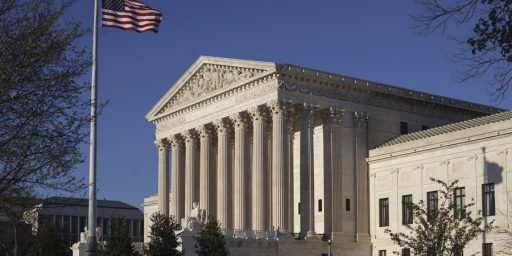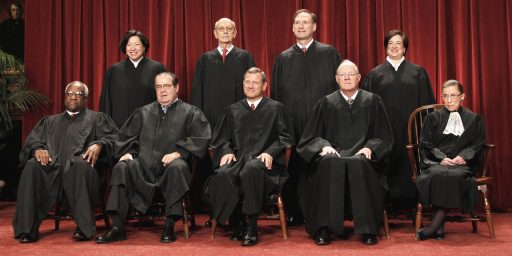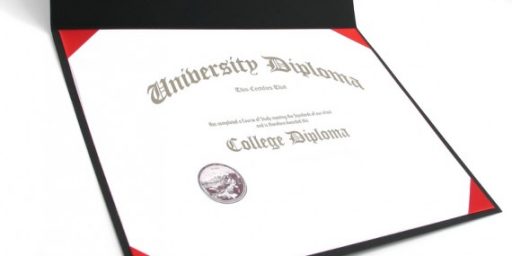Supreme Court Upholds Affirmative Action Based College Admissions Program
In a somewhat surprising opinion from Justice Kennedy, the Supreme Court upheld the University of Texas's race-based admissions program.
In a somewhat surprising ruling that no doubt reflects the impact of the loss of Justice Antonin Scalia, the Supreme Court today ruled that the race-based admissions policy at the University of Texas was Constitutional in a ruling that suggests that we may see at least a temporary pause in challenges to such policies at other educational institutions:
WASHINGTON — The Supreme Court on Thursday rejected a challenge to a race-conscious admissions program at the University of Texas at Austin, handing supporters of affirmative action a major victory.
The decision, Fisher v. University of Texas, No. 14-981, concerned an unusual program and contained a warning to other universities that not all affirmative action programs will pass constitutional muster. But the ruling’s basic message was that admissions officials may continue to consider race as one factor among many in ensuring a diverse student body.
The decision, by a 4-to-3 vote, was unexpected. Justice Anthony M. Kennedy, the author of the majority opinion, has long been skeptical of race-sensitive programs and had never before voted to uphold an affirmative action plan. He dissented in the last major affirmative action case.
Supporters of affirmative action hailed the decision as a landmark.
“No decision since Brown v. Board of Education has been as important as Fisher will prove to be in the long history of racial inclusion and educational diversity,” said Laurence H. Tribe, a law professor at Harvard, referring to the Supreme Court’s 1954 decision striking down segregated public schools.
Roger Clegg, the president of the Center for Equal Opportunity, which supports colorblind policies, said the decision, though disappointing, was only a temporary setback.
“The court’s decision leaves plenty of room for future challenges to racial preference policies at other schools,” he said. “The struggle goes on.”
President Obama hailed the decision. “I’m pleased that the Supreme Court upheld the basic notion that diversity is an important value in our society,” he told reporters at the White House. “We are not a country that guarantees equal outcomes, but we do strive to provide an equal shot to everybody.”
Justice Kennedy, writing for the majority, said courts must give universities substantial but not total leeway in designing their admissions programs.
“A university is in large part defined by those intangible ‘qualities which are incapable of objective measurement but which make for greatness,'” Justice Kennedy wrote, quoting from a landmark desegregation case. “Considerable deference is owed to a university in defining those intangible characteristics, like student body diversity, that are central to its identity and educational mission.”
“But still,” Justice Kennedy added, “it remains an enduring challenge to our nation’s education system to reconcile the pursuit of diversity with the constitutional promise of equal treatment and dignity.”
Justices Ruth Bader Ginsburg, Stephen G. Breyer and Sonia Sotomayor joined Justice Kennedy’s majority opinion. Justice Elena Kagan, who would most likely have voted with the majority, was recused from the case because she had worked on it as solicitor general.
In a lengthy and impassioned dissent delivered from the bench, a sign of deep disagreement, Justice Samuel A. Alito Jr. denounced the court’s ruling, saying that the university had not demonstrated the need for race-based admissions and that the Texas program benefited advantaged students over impoverished ones.
“This is affirmative action gone berserk,” Justice Alito told his colleagues, adding that what they had done in the case was misguided and “is simply wrong.”
Under the University of Texas’ admissions program, most applicants from within the state are admitted under a part of the program that guarantees admission to top students in every high school in the state. This is often called the Top 10 Percent program, though the percentage cutoff can vary by year.
The Top 10 Percent program has produced significant racial and ethnic diversity. In 2011, for instance, 26 percent of freshmen who enrolled under the program were Hispanic, and 6 percent were black. The population of Texas is about 38 percent Hispanic and 12 percent black.
The case challenged a second part of the admissions program. Under it, remaining students from Texas and elsewhere are considered under standards that take into account academic achievement and other factors, including race and ethnicity. Many colleges and universities base all of their admissions decisions on such holistic grounds.
In Grutter v. Bollinger in 2003, the Supreme Court endorsed free-standing holistic admissions programs, saying it was permissible to consider race as one factor among many to achieve educational diversity. Writing for the majority in that case, Justice Sandra Day O’Connor said she expected that “25 years from now,” the “use of racial preferences will no longer be necessary.”
Justice Kennedy’s decision left Grutter intact.
(…)
When the second iteration of the case was argued in December, Justice Kennedy suggested that the court might again send it back to the appeals court. On Thursday, though, he said that would have been a waste of time.
“A remand would do nothing more than prolong a suit that has already persisted for eight years and cost the parties on both sides significant resources,” he wrote. “Petitioner long since has graduated from another college, and the university’s policy — and the data on which it first was based — may have evolved or changed in material ways.”
Justice Kennedy then methodically rejected Ms. Fisher’s arguments. He said the university’s diversity goals were not amorphous but “concrete and precise,” satisfying the constitutional requirement that government racial classifications advance a compelling interest.
Justice Alito described those goals — concerning “the destruction of stereotypes,” promoting “cross-racial understanding” and preparing the “student body for an increasingly diverse work force and society” — as slippery and impervious to judicial scrutiny.
Justice Kennedy wrote that the university was justified in saying that the Top Ten Percent plan did not alone produce sufficient diversity, adding that the holistic part of the admissions program “had a meaningful, if still limited, effect on the diversity of the university’s freshman class.”
Justice Kennedy added that the Top Ten Percent program had built-in limits.
“An admissions policy that relies exclusively on class rank creates perverse incentives for applicants,” he wrote. “Percentage plans ‘encourage parents to keep their children in low-performing segregated schools, and discourage students from taking challenging classes that might lower their grade point averages,'” he added quoting from an earlier dissent from Justice Ginsburg.
“Wherever the balance between percentage plans and holistic review should rest, an effective admissions policy cannot prescribe, realistically, the exclusive use of a percentage plan,” Justice Kennedy wrote.
In his opinion, Justice Kennedy was careful to note that the Court was only ruling on the specific program in place at the University of Texas and the circumstances under which it is applied, not necessarily providing a broader opinion on the use of such programs at other educational institutions or under other circumstances. As Lyle Denniston notes, though, much of the opinion also essentially acts as a guide to the wider academic community about how they can shape their own affirmative action programs in order to survive Constitutional scrutiny in the future:
With Justice Anthony M. Kennedy making a major effort to confine Supreme Court approval of affirmative action on college campuses to one case and one plan, and to limit even that approval to a narrow span of time, the Justices on Thursday barely salvaged the University of Texas’s use of race as a factor in choosing its entering classes. The vote in Fisher v. University of Texas was four to three to allow the Austin campus to continue using an admissions formula it has followed for a dozen years.
Finally rejecting the constitutional challenge that a rejected white applicant had been pursuing for some eight years, the Court in its second review of her case sent few dependable signals to the larger academic community about where race stands as a valid factor in admissions programs. The first tests of how lower courts could react to the ruling could come in lawsuits against Harvard University and the University of North Carolina. Those cases were arranged by the same advocacy organization that had been backing Abigail Noel Fisher of Sugarland, Texas, in her case against the state’s flagship university.
There were three facets of the Kennedy opinion for the majority that stood out:
First, that opinion referred to the Texas approach as “sui generis” — a Latin phrase for one-of-a-kind. That was the strongest indication that Kennedy wanted to signal lower courts that any different plan would have to satisfy the tough test that Kennedy himself had crafted when the Fisher case was decided by the Court in 2013 — a test that, he concluded on Thursday, the UT-Austin plan had passed.
Second, it stressed that campus leaders in Austin should not interpret the new decision as necessarily meaning that they could continue to follow the same policy, with its partial use of race, without changing it if circumstances change.
Third, it expressly ordered the university “to engage in constant deliberation and continued reflection regarding its admissions policies.” This phrasing appeared to forecast a future vulnerability for the university if it did not regularly review its policy in the future to see if the consideration of racial factors was still necessary to achieve its academic goal of a racially diverse student body.
As I’ve said before, this is an issue that the Supreme Court has been dealing with for more than thirty-five years now, and while it has largely danced around the issue, it appears that the Justices have come to the point where they have to confront the issue directly whether they’d like to or not:
The dancing started with Regents of the University of California v. Bakke in 1978. While the Court did not fully reject the idea of race-based admissions policies in Bakke, it also didn’t completely approve it either, a mixed holding that seemed to suggest that universities could have policies that took race and ethnicity into account but that anything that resembling quotas. The problem was that the opinion wasn’t very specific about where the difference between permissible race conscious and impermissible quotas might actually lie. What followed theBakke decision was a long era in which admissions authorities tried to determine what exactly is acceptable under the 14th Amendment’s Equal Protection Clause which, as a general rule, bars race-based discrimination by government entities, including public universities. The Court didn’t provide much guidance on the issue in the intervening years until a 2003 case called Grutter v. Bollinger where the Court upheld an affirmative action policy in place at the University of Michigan Law School that used race as a factor with the purported goal of increasing class diversity. The decision still didn’t necessarily resolve many of the questions left by Bakke and it especially left many conservatives unsatisfied to the point where many hoped that the opportunity to deal with the issue head-on would finally arrive once Justice Sandra Day O’Connor, who was the deciding vote in Grutter, retired.
It was widely anticipated that Fisher would be that case, but instead things have gone very differently. This case has a long and tortured history that goes back nearly a decade at this point and includes two trips to the Supreme Court, which is quite the rarity for any case. Four years ago, notwithstanding the fact that oral argument in the case had made it seem as though there would be enough support for a sweeping ruling barring the use of race-based preferences in admissions, the Supreme Court ended up punting the case back to the District Court with orders that the Court reexamine the evidence in the case. Both the District Court and the Circuit Court of Appeals did just that and the outcome below was largely the same, with the program that provided some means for being taken into account in admissions being upheld by both the the District Court and the Circuit Court. For some time, though, it had been assumed that the departure of Sandra Day O’Connor meant that there was now a majority on the Court in favor of the prospect striking down such admissions programs, so when the Court accepted the case for argument again, it was widely assumed that the days of affirmative action were numbered, especially since the fact that Justice Kagan was forced to recuse herself in the case due to her involvement with the case while serving as Solicitor General meant that the liberal wing of the Court was down one to begin with. What nobody anticipated, and which certainly could not have been gathered from the oral argument in this case back in December, is that Justice Kennedy would break a long record and end up voting in favor of an affirmative action program, which he had not done when the issue came before the Court in the past.
The most notable thing about this decision, I think, is the fact that it appears to clearly endorse the argument that educational institutions have made in the past that race-based admissions policies are necessary not just because they stand as some sort of reparations for past discrimination, but also because of the perceived benefit of a diverse student body. When race-based preferences are justified as a method of making up for past discrimination, there is an unstated assumption that there would have to be some kind of timetable for ending such programs. After all, as many critics of affirmative action have noted in the past, at some point the time period during which minorities were discriminated against in immigration comes to be so far in the past that arguing that such programs are needed to compensate for past discrimination tend to lose credibility. In recent years, though, institutions such as the University of Texas have argued that their programs are justified not as reparations but because of the inherent educational and cultural value of having a diverse student body that mirrors the nation as a whole to some degree. With that as the main criteria, it becomes harder to criticize the programs as outdated or unnecessary, and admissions offices are given far more authority to implement these policies without fear of being sued at the drop of a hat. Reading Justice Kennedy’s opinion, it’s clear that the Court has essentially fully accepted this argument based on diversity and, if that’s the case, that it will be far less likely to question such programs in the future. That doesn’t mean that affirmative action of all types will be considered acceptable or pass Constitutional muster, but it will be far easier for admissions offices to argue that their policies are exist for valid educational reasons. Whether or not that’s a good thing is another question.
Here’s the opinion:







It strikes me as the correct decision. Having a diverse student body, not just racially but in terms of skills, background, geography is at the hearts of pretty much every admission committee. Prohibiting them from considering race the same way they consider other characteristics seems wrong.
I wasn’t surprised. The Court has shown a willingness to back away a bit from affirmative action but not a willingness to abandon it completely.
Who zlktujhlsktghalsktjhletngzswetknzseklhn….. Let me try again.
Who the l;szdkgh;zSLIKGH;zlsgfhz;sltgfh;…… One more time.
Who the fuzsikhgt;litsz;lhgtl’;otglhgt….. OK I give up. Really? I mean Really??? Past discrimination???? PAST?????
Haysoos crisco open your eyes. The discrimination isn’t past, it is occurring every day. It shows in the actions of our state legislatures, it shows in the school funding…. Hells bells MO Republicans just massively cut the state funding for schools, their logic being the school districts can just raise the funds on their own. No problem if you live in the Clayton or Ladue school districts, majority lilly white and affluent, but if you live in the Rverview or Florrissant or St Louis school districts, majority black and working class to poor, you just got a royal rogering. The tax base isn’t there.
But racism has nothing to do with it, no no nothing at all, it’s about local control, yeah that’s the ticket….. The fact that these children will get an even more substandard education is just one of the eggs that has to be broken in order help make the omelet that is a reinforcement of the racial socioeconomic status quo is beside the point and purely accidental….
Keep f*#cking that chicken.